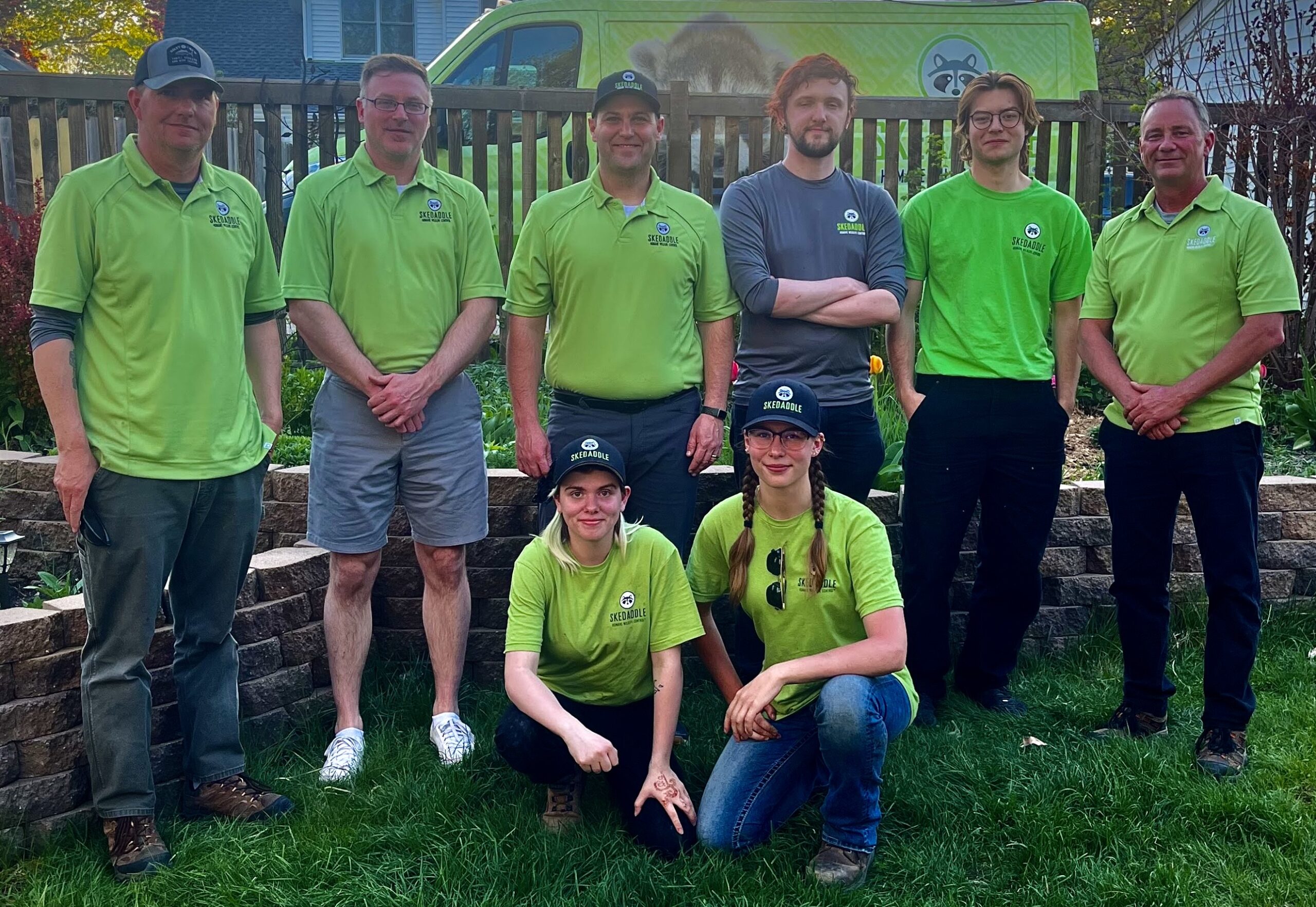SKUNK REMOVAL PROCESS
Assess and Remove
To solve a skunk problem, we start with a complete assessment of your property to determine where the skunks are living and how they’re gaining access. Since skunks do not climb our inspection will focus on the ground level den sites like porches, decks and sheds. We then perform a careful and humane removal, including any babies.
Clear and Clean
Once we humanely remove any skunks and their babies we will move on to clearing the den site of any damaged property, nesting material or debris that was gathered by the animals. We can then begin cleaning, disinfecting and deodorizing the area to eliminate any risk of illness, irritating odors and attractants for other wildlife.
Prevent and Protect
To prevent a future skunk problem, our technicians will get to work installing protective barriers designed to keep skunks out. This usually involves digging out around the perimeter of the deck, shed or porch and burying a heavy steel mesh deep into the ground. Our workmanship and materials are backed by a lifetime warranty.
Skunks are cute, cuddly creatures with distinctive white stripes on their backs. They thrive in a variety of environments, so you can come in contact with this animal as easily in an urban environment as you can in a forest. One of the most commonly known facts about skunks is that they spray a noxious odor when they feel threatened, so knowing how to interact with skunks and when to call an expert for skunk removal in Minneapolis is important.
Skunks may be relatively docile creatures, but they can still pose a hazard to your health. They can spread diseases through their droppings and rabies through their bites and scratches, so it is never a good idea to welcome skunks near your house. Contacting a professional for skunk removal is always a better option than attempting the process yourself.
Why Skunks Thrive in Minneapolis
Minnesota is home to two skunks species; the striped skunk and less common eastern spotted skunk. The striped skunk is the one you’re mostly likely to see or smell in Minneapolis. Striped skunks are adaptable creatures that live in many regions. They thrive anywhere from densely populated cities to rural countryside.
Skunks are well suited to city life in part because cities provide plenty of food shelter opportunities. They each eat just about anything and will adapt their diet to what is available to them at any given time. White grubs are often a favorite and can be found in the front and back lawns across Minneapolis. Skunks don’t climb particularly well and prefer to make their home at ground level. In nature they might burrow below a downed tree or brush pile but in cities they prefer the spaces below decks, porches and outbuildings like sheds and garages.
Where To Find Skunks On Your Property
Skunks don’t tunnel like groundhogs but they are capable diggers and easily pull away soil to get below structures like decks, sheds, porches and crawl spaces. You’re likely to see a hole or pile of disturbed earth near their entry points. Skunks mate in late winter in Minneapolis, after most of winter’s snow has melted, and babies usually arrive in May and June. Skunk babies are born naked, blind, and helpless so their mother’s need secure den sites to stash them away until they become mobile, usually 6-8 weeks after birth.

What Skunks Do When They Feel Threatened
The potential for skunk spray is the biggest risk when skunks decide to take up residence under your deck, porch or shed. Skunks are nocturnal, so they are rarely active during daylight hours when humans and pets are outside. They are not aggressive animals and rarely take the offensive. Their foul spray is a last resort but when released under a structure close to your house the smell can work its way into your home and linger for weeks on end.
Your dog could also be at risk. One look at a backyard skunk can be enough to set off a reaction in your dog. They are frequently on the receiving end of skunk spray when they startle, corner or threaten a skunk. Anyone who has ever had to wash a skunked dog knows just how potent the odor can be.
It’s not just their spray you have to be concerned with either. Skunks are the top rabies carrier among mammals in Minnesota and the disease spreads by way of a bite or scratch. Of course, your dog is at far greater risk for a run in if skunks happen to be living under a structure on your property.
At the first sign of skunk activity it is best to have your property inspected for signs of a den. Removing and preventing skunks from taking up residence is the best way to protect against skunk spray and rabies.
How Skedaddle Can Help With Humane Skunk Removal
Skunks are hard to get rid of because they are excellent diggers and burrow inside tight holes under decks, porches and outbuildings. It’s hard to reach them without the proper tools and experience, and you run the risk of being sprayed if you aren’t careful.
We first assess the situation to determine how skunks have made entry. We can then arrive at a removal and prevention plan based on our findings. Setting traps for skunks isn’t an effective strategy for skunk removal because you cannot be certain you will catch the skunk you’re after and not a neighborhood squirrel or raccoon.
Skedaddle uses hands-on techniques to carefully lure skunks out from their dens and then install barriers to prevent re-entry. We never want to separate a mother from her babies for too long, so during the spring and summer birthing we look to carefully remove skunk babies from hard to reach places and use them to lure their mother out. We then reunite the mother with her babies outside the deck, porch or shed so she can relocate them to one of her other den sites in the area.
To ensure the current group of skunks and any others in your neighborhood don’t move back in, we reinforce the perimeter of the deck, shed or porch to prevent reentry. In most cases that involves digging around the perimeter of the structure and burying a heavy gauge wire mesh into the ground. With a barrier in place that they cannot dig through or under we will have protected your property from smelly guests.
Contact an Expert for Help With Skunk Removal in Minneapolis
Getting rid of skunks on your property is not an easy process. The striped animals are rarely aggressive unless they feel threatened, but you don’t want to startle them and become a victim of the noxious odor they spray. It’s best to leave skunk removal in
Minneapolis to a professional. Skedaddle Humane Wildlife Control knows how to get rid of skunks using humane and permanent methods, so contact us today to schedule an appointment for removal.
Skunk Facts
FACT:
Skunks do not go into hibernation to survive Minneapolis winters. Instead, they go into a state of decreased physiological activity called torpor. During this time, skunks reduce their body temperature and metabolic rate and rarely venture outside the den.
FACT:
Skunks are immune to the venom of many snakes, including rattlesnakes and copperheads. They’re known to eat these snakes, making them a valuable asset to farmers and gardeners who want to keep snake populations under control.
FACT:
Skunks are omnivores, and the vast majority of their diet includes; plants, small animals and insects
FACT:
Skunks have extremely poor eyesight, and they are nearsighted. This means that they rely on their sense of smell to identify predators, locate food as well as to communicate with other skunks in the area.





